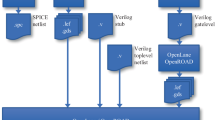Abstract
Many radar sensor systems demand high performance front-end signal processing. The high processing throughput is driven by the fast analog-to-digital conversion sampling rate, the large number of sensor channels, and stringent requirements on the filter design leading to a large number of filter taps. The computational demands range from tens to hundreds of billion operations per second (GOPS). Fortunately, this processing is very regular, highly parallel, and well suited to VLSI hardware. We recently fielded a system consisting of 100 GOPS designed using custom VLSI chips. The system can adapt to different filter coefficients as a function of changes in the transmitted radar pulse. Although the computation is performed on custom VLSI chips, there are important reasons to attempt to solve this problem using adaptive computing devices. As feature size shrinks and field programmable gate arrays become more capable, the same filtering operation will be feasible using reconfigurable electronics. In this paper we describe the hardware architecture of this high performance radar signal processor, technology trends in reconfigurable computing, and present an alternate implementation using emerging reconfigurable technologies. We investigate the suitability of a Xilinx Virtex chip (XCV1000) to this application. Results of simulating and implementing the application on the Xilinx chip is also discussed.
Similar content being viewed by others
References
G.W. Stimson, Introduction to Airborne Radar, 2nd edn., Scitech Publishing, Inc., 1998.
J. Ward, “Space-Time Adaptive Processing for Airborne Radar, ” Technical Report #1015, MIT Lincoln Laboratory, Dec. 1994.
A.V. Oppenheim and R.W. Schafer, Discrete-Time Signal Processing, Prentice Hall, Inc., 1989.
K. Teitelbaum, “A Flexible Processor for a Digital Adaptive Array, ” in Proceedings of the 1991 IEEE National Radar Conference, March 1991.
E.D. Baranoski, “Pre-Processor Specifications, ” Internal Memorandum, 21 April 1995.
J. Greco, “A1000 Critical Design Review, ” MIT Lincoln Laboratory, June 1996.
“Xilinx Celebrates 15th Year of Continuous Innovation in Programmable Logic, ” Xilinx Press Release, Feb. 1999, http://www.xilinx.com/company/anniversary.htm.
“The Future of FPGAs, ” Xilinx White Paper, http://www. xilinx.com/prs rls/5yrwhite.htm.
K. Chapman, “Building High Performance FIR Filters Using KCMs, ” Xilinx App Note, July 1996, http://www.xilinx. com/appnotes/kcm fir.pdf.
G.R. Goslin, “A Guide to Using Field Programmable Gate Arrays (FPGAs) for Application—Specific Digital Signal Processing Performance, ” Xilinx, Dec. 1995, http://www.xilinx. com/appnotes/dspguide.pdf.
L. Mintzer, “Large FFTs in a Single FPGA, ” in Proceedings of the 7th International Conference on Signal Processing Applica-tions & Technology, Boston, MA, 7–10 Oct. 1996.
B. Allaire and B. Fischer, “Adaptive Filters in FPGAs, ” in Proceedings of the 7th International Conference on Signal Processing Applications & Technology, Boston, MA, 7–10 Oct. 1996.
“Xilinx Core Solutions Data Book, ” Xilinx, 2/98, http://www. xilinx.com/products/logicore/core sol.htm.
“A Simple Method of Estimating Power in XC4000XL/EX/E FPGAs, ” Xilinx Application Brief XBRF014 v 1.0, June 1997, http://www.xilinx.com/xbrf/xbrf014.pdf.
“PowerPC 603e Microprocessors, Motorola, ” http://www.moto-rola. com/SPS/PowerPC/products/semiconductor/cpu/603.html.
“PowerPC 750 and PowerPC 740 Microprocessors, ” Motorola, http://www.motorola.com/SPS/PowerPC/products/semicon-ductor/ cpu/750.html.
W. Song, “A Two Trillion Operations per Second Minature Mixed Signal Radar Receiver/Processor, ” in Asilomar Conference on Signals, Systems, and Computers, Nov. 1998.
T.J. Moeller and D.R. Martinez, “Field Programmable Gate Ar-ray Based Front-End Digital Signal Processing, ” in IEEE Symposium on Field-Programmable Custom Computing Machines, FCCM'99, April 1999.
.J. Moeller, “Field Programmable Gate Array for Front-End Digital Signal Processing, ” Master of Engineering Thesis, Massachusetts Institute of Technology, May 1999.
G.R. Goslin, “Using Xilinx FPGAs to Design Custom Digital Signal Processing Devices, ” in DSPX 1995 Technical Proceedings, 12 Jan. 1995, p. 595.
G.R. Goslin, “Implement DSP Functions in FPGAs to Reduce Cost and Boost Performance, ” EDN, 1996.
B. New, “A Distributed Arithmetic Approach to Designing Scal-able DSP Chips, ” EDN, 17 Aug. 1995.
Xilinx Publications, “The Role of Distributed Arithmetic in FPGA-based Signal Processing, ” Technical Report.
S.A. White, “Application of Distributed Arithmetic to Digital Signal Processing: A Tutorial Review, ” IEEE ASSP Magazine, July 1989.
Author information
Authors and Affiliations
Rights and permissions
About this article
Cite this article
Martinez, D.R., Moeller, T.J. & Teitelbaum, K. Application of Reconfigurable Computing to a High Performance Front-End Radar Signal Processor. The Journal of VLSI Signal Processing-Systems for Signal, Image, and Video Technology 28, 63–83 (2001). https://doi.org/10.1023/A:1008111205690
Published:
Issue Date:
DOI: https://doi.org/10.1023/A:1008111205690




